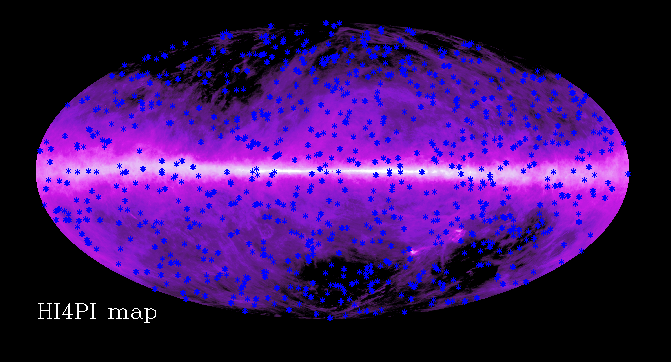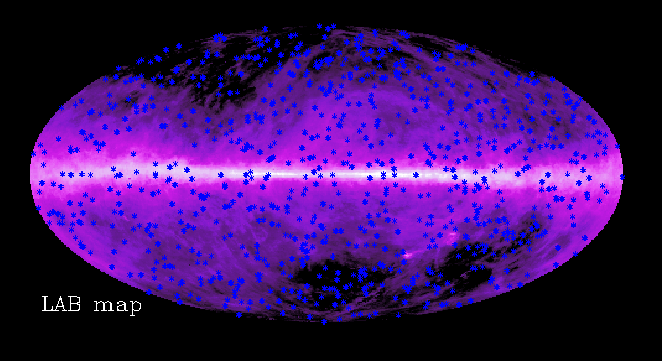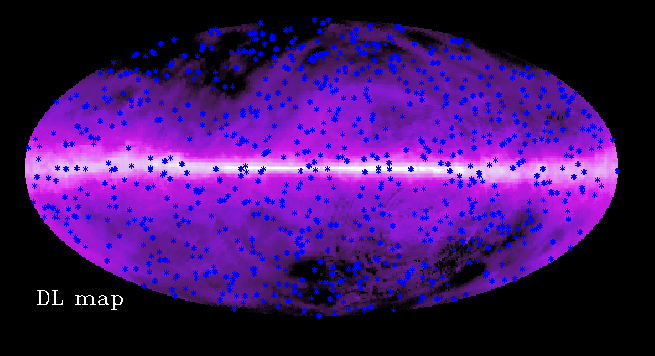NH Help
- Introduction
- Description
- Cone Radius Parameter
- Map Parameter
- HI Map Comparison
- How does NH relate to X-ray and extreme-ultraviolet (EUV) spectra?
Introduction
NH is set up as a World-Wide Web interface to the command-line version of the 'nh' FTOOL. As such, it incorporates some of the features and all of the limitations of 'nh'. It returns hydrogen column density for a given radius around an astronomical position (right ascension and declination).
Description
'nh' returns, for a specified right ascension and declination, a value for the hydrogen column density, NH. This value is derived from the 2D HI4PI map, a full-sky HI survey by the HI4PI collaboration 2016, Astronomy & Astrophysics, 594, A116. The HI4PI survey is based on data from the recently completed first coverage of the Effelsberg-Bonn HI Survey (EBHIS) and from the third revision of the Galactic All-Sky Survey (GASS). The HI4PI map pixel size is 0.0833 deg x 0.0833deg and there are about 15 pixels around the galactic center position set with negative values. See also the HI4PI site for additional details.
Previous 'nh' versions used different maps to derive NH values. They are the (a) HI map by Kalberla et al. 2005, Astronomy & Astrophysics, 440, 775, known as the Leiden/Argentine/Bonn (LAB) survey and (b) the HI map by Dickey & Lockman (DL), 1990, Ann. Rev. Ast. Astr. 28, 215. They are still released with the software for back compatibility; however, the HI4PI map outperforms the LAB and DL maps.
The LAB map was obtained by merging two surveys covering HI radial velocities from -400 km/s to +400 km/s – the Leiden/Dwingeloo Survey (Hartmann & Burton 1997), and the Instituto Argentino de Radioastronomía Survey (Arnal et al. 2000 and Bajaja et al. 2005). The resulting velocity integrated combination had a resolution of approximately 0.5°, and was resampled onto 0.675° × 0.675° bins in L and B. The DL map was obtained by merging several surveys (see Dickey & Lockman 1990) and averaged into 1° × 1° bins in L and B. These maps were provided by K. Kuntz and S. Snowden respectively and still released with the software for backwards compatibility.
See HI Maps Comparison for details on the different maps.
The NH values are in units of hydrogen atoms × cm-2. The software calculates an average NH using values within N° from the request position (N is the Cone Radius parameter). Two NH average values are output for the requested map (see Map Parameter): a simple average and an average weighted by the inverse of the distance from the request position. If no pixels are found within N° of the Cone Radius parameter, the closer value is reported.
NOTES:
1) Previous versions of this program used the LAB and/or DL maps to calculate NH.
2) The maximum NH value from the DL map is 2.58×1022 cm-2 at RA (2000)=15h 59m 29.383s Dec (2000)=-53d 04m 40.04s corresponding to (l, b) = (329.0, 0.0). In Dickey & Lockman (1990), this is instead printed as (l, b) = (339.0, 0.0), which is assumed to be a typo.
Cone Radius Parameter
Only NH values within N° are used in the calculation, where N is the value entered in the Cone Radius box. For the HI4PI map the default is to use all points within 0.1°. For the LAB and DL maps the default is 1° since their pixel size is much larger.
NOTE: Increasing the radius may lead to erroneous values for NH. Decreasing the search radius to values similar to the map pixel size may return NH from the closer pixel.
Map Parameter
This option lets one choose which map to use for the NH calculation. The default map is the HI4PI. See Description section for information about each map, and refer to HI Maps Comparison for more information regarding the maps.
HI Maps Comparison
The resolution of the HI4PI is higher compared to the LAB and DL maps with a pixel size of 0.085, 0.675 and 1 ° respectively. The Large and Small Magellanic Clouds are visible in the HI4PI and LAB maps but not on the DL. Figure 1 shows these differences.
To check the results from the HI4PI map as used in the FTOOL 'nh', 770 sky positions randomly distributed were used as input to the HI4PI Survey web form, and to the FTOOL 'nh' and the ouputs compared. There is a very good agreement between the two methods. Figure 2 shows a plot of the NH calculated with the HI4PI map in the FTOOL 'nh' versus that calculated using the HI4PI Survey web form, along with the best fit line to the data.
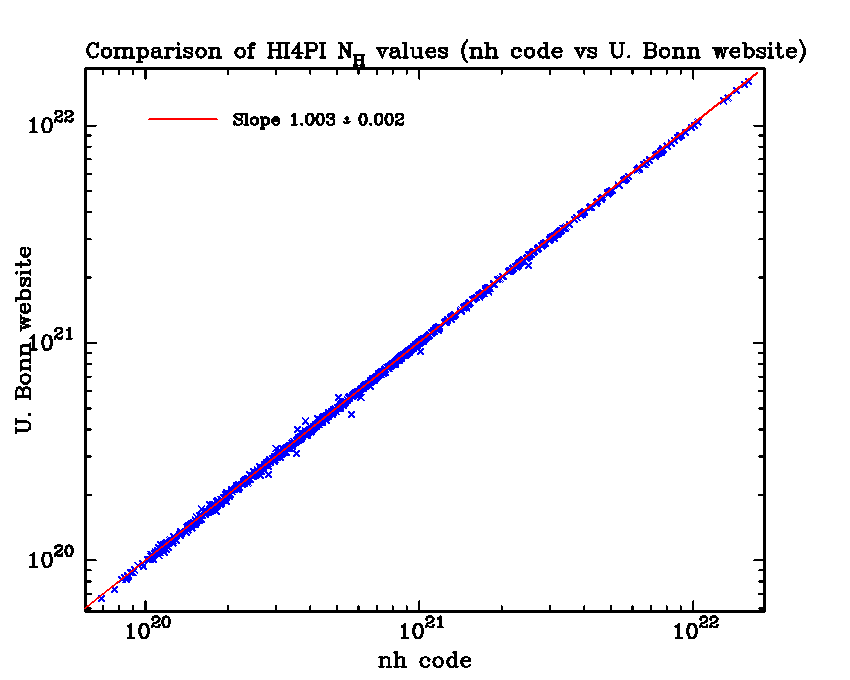
|
| Figure 2. NH values calculated with the HI4PI map using 'nh' versus the HI4PI Survey web form. The best fit line to the data is plotted in red. |
Figure 3 and 4 show the differences between these HI maps using within the FTOOL 'nh', when using the ∼770 positions randomly chosen on the sky. The NH values were calculated with the FTOOL 'nh' for each location for the maps. The Cone Radius was set to 0.1° for the HI4PI map and 1° for the Lab and DL. Figure 3 shows a plot of the NH calculated with the HI4PI versus LAB map, along with the best fit line to the data.Figure 4 shows a plot of the NH calculated with the HI4PI versus DL map, along with the best fit line to the data. In both cases the relation is linear, as expected, and it is tighter going from the DL to the LAB.

|
| Figure 3. NH values calculated with the HI4PI map versus the LAB map. The best fit line to the data is plotted in red. |
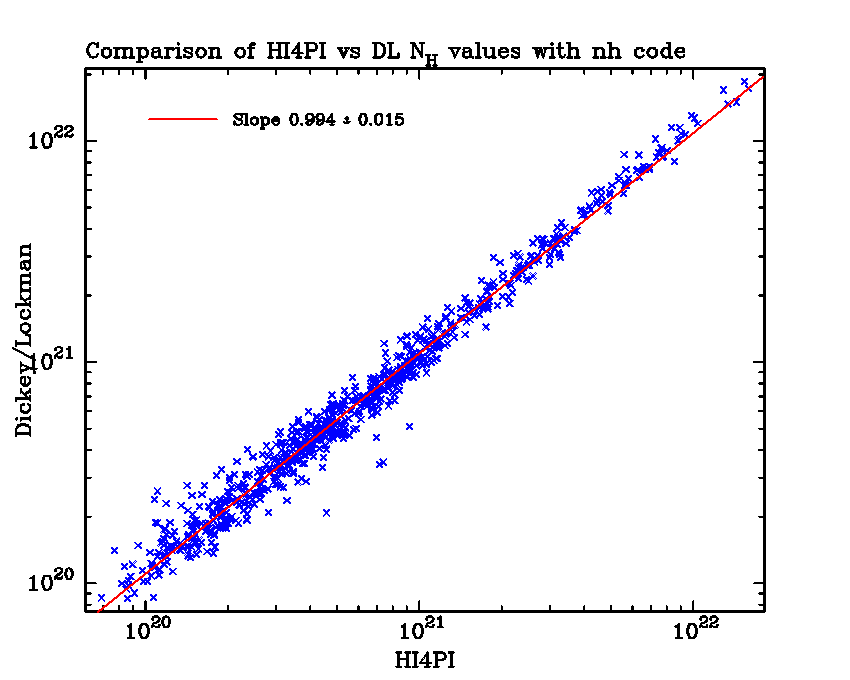
|
| Figure 4. NH values calculated with the HI4PI map versus the DL map. The best fit line to the data is plotted in red. |
How does NH relate to X-ray and extreme-ultraviolet (EUV) spectra?
If large enough, the column density of gas between an X-ray/EUV source and the Earth will absorb radiation (particularly at the softer energies) and consequently alter the overall spectral shape. This effect can be calculated using the standard formula, tau = sigma x NH, where tau is the optical depth and sigma is the cross-section. Since sigma is a steep function of energy E (or, equivalently, wavelength w), so is tau. Some typical values of sigma for a gas with properties and abundances similar to the nearby interstellar medium are 6 x 10-20 cm2 at 0.07 keV (175 Angstroms), 4 x 10-21 cm2 at 0.25 keV (50 Angstroms), 2 x 10-22 cm2 at 1 keV (12 Angstroms), and 1 x 10-23 cm2 at 10 keV (1.2 Angstroms). These cross-sections imply that a column density of >= 8 x 1019 cm-2 will absorb most (EUV) emission with energies below 0.07 keV (w > 175 A), NH >= 1 x 1021 cm-2 most soft X-rays and EUV emission with E < 0.25 keV (w > 50 A), NH >= 2 x 1022 cm-2 most emission below 1 keV (w > 12 A), and NH >= 5 x 1023 cm-2 will essentially suppress almost all of the emission in the Chandra and XMM-Newton bands, i.e., all energies below 10 keV (w > 1.2 A). (For these estimates, we have quoted the NH values equivalent to an optical depth of 4.5, i.e., an attenuation factor e-tau of 1%, at the stated energies.)
Thus, for example, heavily absorbed X-ray sources with NH > ~1023 cm-2 (equivalent to an optical reddening E(B-V) > ~20 magnitudes, using the relation NH = 5 x 1021 x E(B-V) valid for a standard gas to dust ratio) were typically not detectable by the ROSAT X-ray detectors as these latter were only sensitive to X-rays with energies E < 2.5 keV.
This file was last modified on Monday, 21-Apr-2025 17:48:29 EDT
NH is a web interface to the NH FTOOL. NH was developed by Lorella Angelini at the HEASARC. The web interface is maintained by Edward J. Sabol of the HEASARC.

